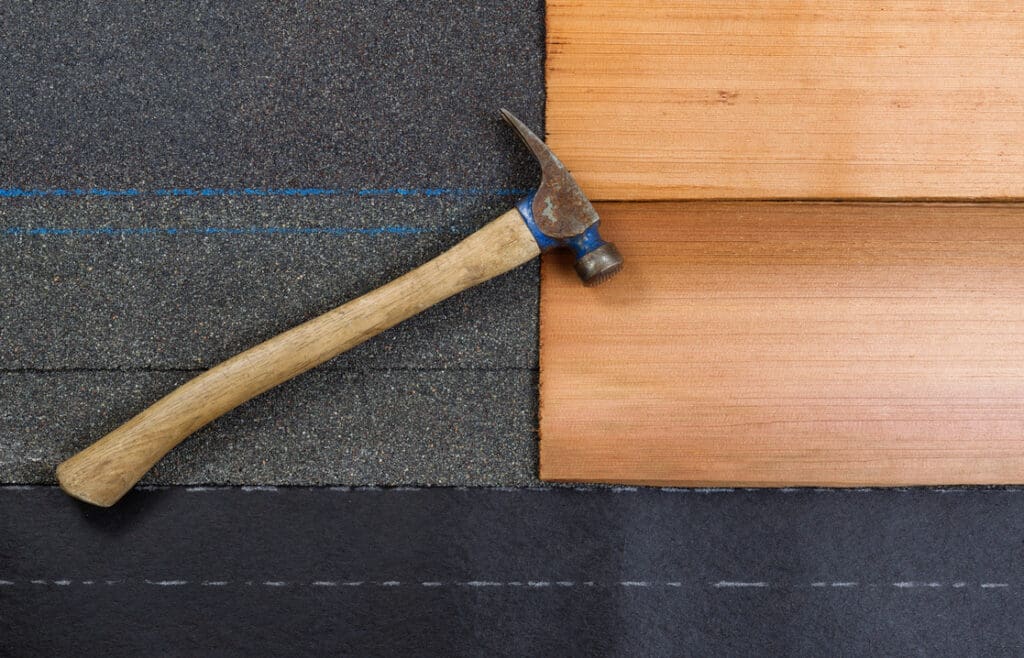
Updated on December 2, 2025
Your roof says a lot about your house. The type of material you choose contributes greatly to the overall look, as well as its ability to protect what’s inside.
For decades, asphalt singles were the standard, and that’s practically all we saw in neighborhoods. Today you can choose from all types of materials, like metal roofs, tile, wood shakes, plastic, copper, slate and more. There’s even one type designed by MIT students that could change colors!
With all these choices, how do you select the material that’s not only best for your home, but for your budget as well? Here are 6 questions to ask, beyond just the look, when choosing a roof material.
How Durable Is It?
Your new roof will cost a lot of money. Like all good long-term investments, it makes sense to find the material that will last as long as possible. Here are typical lifespans for common roofing materials:
Asphalt shingles: 15 years
Laminated asphalt shingles: 25 years
Wood shakes: 25 years
Metal, like aluminum, copper, steel, lead, and copper-and-asphalt: 50 years or more
Clay tile: 100 years or more
Cement, used in the half-cylinders for Southwest style roofs: 50 years or more
Slate: 100 to 150 years, or more
Plastic polymer: 50 years or more
Can My House Handle the Weight?
Materials vary significantly in how much load they put on your home’s structure. Some home frames are unable to sustain certain types of roofing materials. You’ll want to consult with a contractor about this as you choose the material. Here is a look at the weights of common roofing materials, per hundred square feet:
Asphalt shingles: 190 to 250 lbs.
Laminated asphalt shingles: 240 to 340 lbs.
Wood shakes: 300 to 400 lbs.
Metal: 50 to 270 lbs.
Tile: 900 lbs. or more
Slate: 900 lbs. or more
Plastic polymer: 70 to 300 lbs.
Can It Survive the Weather in My Area? Is It Up to Local Codes?
If you live in an area where hurricanes or wildfires are common, local building codes have a say in your roofing material. Though hurricanes aren’t common in the Portland-Vancouver area, high winds do happen to occur. And wildfires can happen in any rural or semi-rural area. The right type of roofing material can withstand weather extremes and help protect your home.
Here is a look at how common roofing materials handle weather problems:
Asphalt: does well resisting fire and is fair in resisting wind.
Wood shakes: poor choice for fire-prone areas, though it can be treated with fire retardant. It has good resistance to the wind.
Metal: resists both wind and fire well.
Tile: an excellent choice for resisting fire, but just fair for wind resistance.
Slate: a good choice for both wind and fire.
Plastic polymer: offers good resistance to both wind and fire.
Does It Add to the Look of My House?
The best way to understand how the material will affect the appearance of your home is by visiting houses with a range of roofing choices. For a realistic appraisal, check out homes with slate, steel, plastic polymer, shakes, shingles—whatever material you are considering.
General aesthetics are as follows:
Wood shakes add a rustic look. Copper and slate give a home an upscale touch.
Many materials come in several colors. Though people usually picture asphalt shingles as a drab brown or green, they actually come in a wide range of shades, like purple, yellow, red and blue.
Metal comes in every color imaginable, and can also mimic the look of tile, shakes and slate. The same is true of plastic polymer, which is made to look like slate or wood. Concrete tile, less expensive than clay tile, has the traditional Southwest look, but can also look like wood shakes and slate.
Is it Environmentally Friendly?
Choosing green products is becoming more popular, especially in a time of growing concern about the environment. Here is how popular roofing choices rate:
Asphalt: petroleum-based, making them not environmentally friendly but recyclable.
Wood shakes: made from a natural material, so they are definitely considered green.
Metal: often made from recycled material, and they can be recycled in turn.
Tile: it takes a lot of energy to produce both clay and concrete tiles. But they are made from natural materials.
Slate: this is a natural material, so entirely green.
Plastic polymer: these are often made from recycled material, and can be recycled themselves.
Does It Fit My Budget?
Roofs are large, use lots of materials and cost a lot of money. But different materials vary in price dramatically. Experts recommend investing in the highest quality roof you can afford.
Here is a general range to get an idea of costs. The first set of numbers shows the cost per square, which is 100 square feet. The second set refers to the price of labor and materials over the projected lifespan of the material.
Asphalt: $75 to $125 / $4 to $8 a year
Wood shakes: $350 to $450 / $14 to $30 a year
Metal: $250 to $450 / $5 to $15 a year
Clay tile: $800 to $1,000 / $13 to $20 a year
Concrete tile: $300 to $500 / $5 to $10 a year
Slate: $1,100 to $2,000 / $10 to $20 a year
Plastic polymer: $400 to $650 / $7 to $13 a year
That’s a lot of data, and it takes time to figure out how to apply it to your individual home. Are you wondering what would work best for your needs?
The team at Warner Roofing has been helping people just like you choose new roof materials since 1992. Tap into their expertise. They welcome your questions and are happy to provide a free, no-obligation estimate.
Please Note: Warner Roofing does not do metal roofing.